Louis Chevalier (Jean Louis Joseph Chevalier), ca. 1778 - 1848
"L. Chevalier et Fils" after 1848
by Brian Stevenson
last updated January, 2022
Louis Chevalier was a relatively minor Parisian microscope maker, who is most notable for having been a younger brother of the well-known microscope manufacturer Vincent Chevalier (1771-1841). Only one microscopes from a Louis Chevalier business is known to survive, a ca. 1848 drum-type compound instrument signed "L. Chevalier et Fils" (Figure 1). The 1828 Dictionnaire Technologique ou Nouveau Dictionnaire Universel des Arts et Metiers stated that Louis Chevalier then made achromatic lenses in the style of his brother, Vincent. From 1849 onward, Louis manufactured simple microscopes with lenses and object holders that could be adjusted to any angle, which were useful for comparing hallmarks on pieces of jewelry, etc. Examples of that microscope type has not yet been identified.
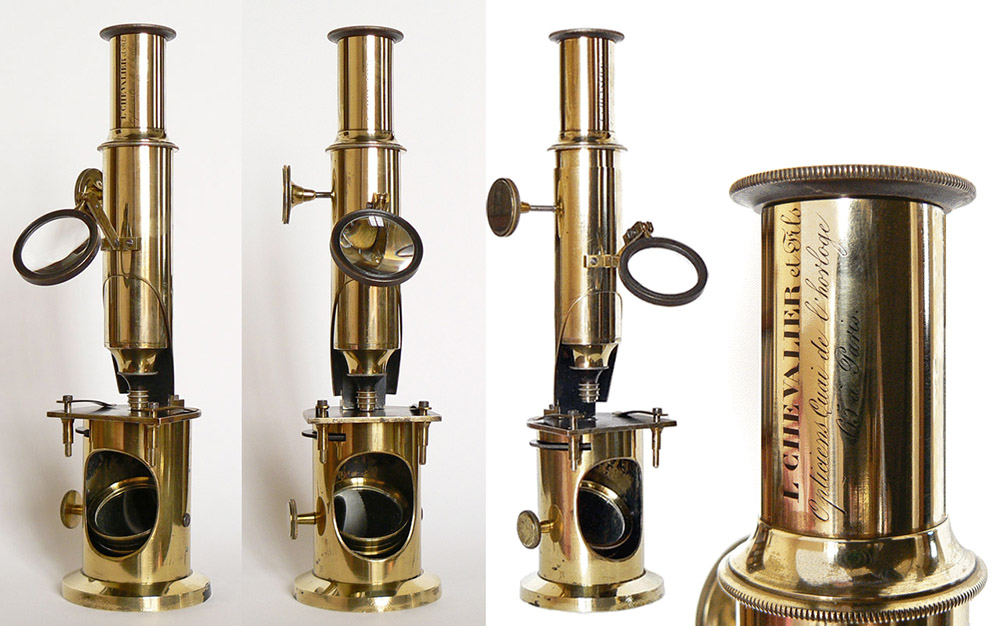
Figure 1.
Datable to 1848, a compound microscope by Louis Chevalier et Fils. The business assumed that name during late 1847 or early 1848. It is engraved with the address 65 Quai de l'Horloge. The shop number changed to 25 during 1848. Adapted by permission from http://www.lecompendium.com/dossier_optique_31_grand_microscope_a_niche_l_chevalier/Microscope_a_niche_chevalier.htm.
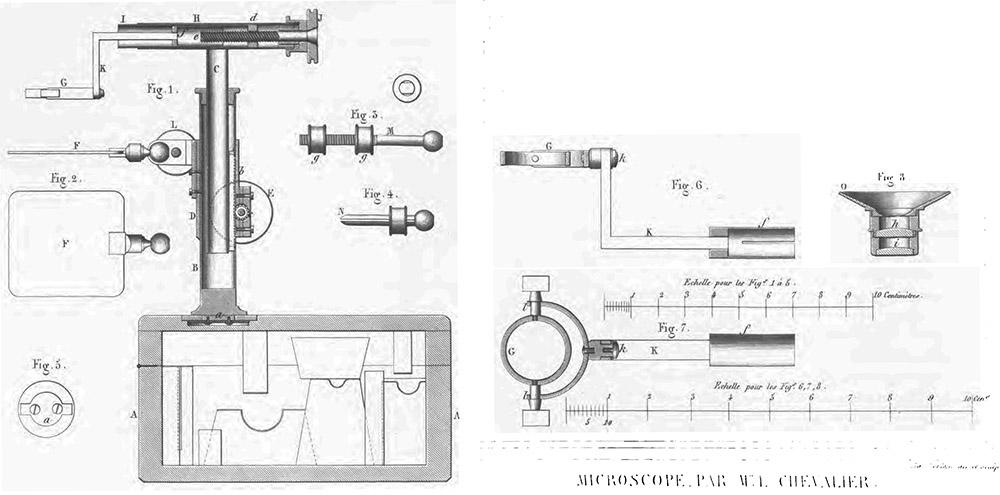
Figure 2.
1849 diagrams of an L. Chevalier et Fils inspection microscope, from "The Bulletin de la Société d'Encouragement pour l'Industrie Nationale". It was designed for examining hallmarks on jewelry and other such objects. A doublet lens (Fig. 3, far right) fits into a lens holder ("G" in Figs. 1, 6, and 7). The lens holder is mounted on a gimbal, allowing the angle of view to be readily adjusted. A screw drive moves the lens in-and-out, and the mount pivots, to further adjust the lens position. A rack-and-pinion raises/lowers the lens for focusing. The object to be inspected is either placed on a flat stage ("F" in Figs 1 and 2) or in one of two clamping devices (Figs. 3 and 4). The stage and clamps attach by ball-and-socket joints, which allow them to be adjusted in any direction. The 1849 "Bulletin" reported that Chevalier et Fils had begun producing a similar microscope with a pair of parallel lenses and stages, which purportedly could permit a user to compare two objects simultaneously.
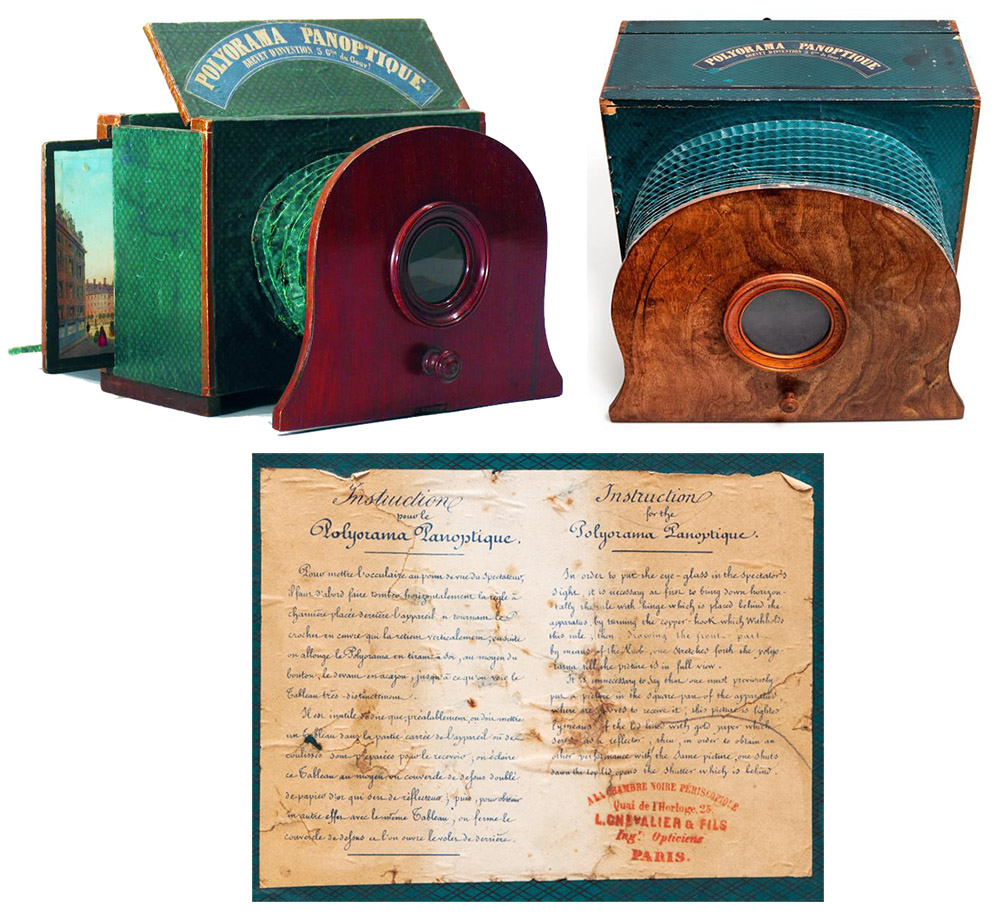
Figure 3.
Two ca. 1850 "Polyoramas", and an attached instruction label, from L. Chevalier et Fils. The user looks through the front lens toward a picture that is printed on translucent tissue paper. The hinged top has a mirror on the underside, and the rear of the box is open. When viewed with the top opened, light is reflected onto the front of the image. Slowly closing the lid reduces reflected light and brings in light from the back, which darkens the front image and illuminates a second image that is embedded in the tissue. The effect may be to turn a scene from daytime to night, or change to a completely different scene (see Figure 4). Adapted for nonprofit, educational purposes from the Museum of Cinema-Tomàs Mallol Collection, and from an internet auction site.
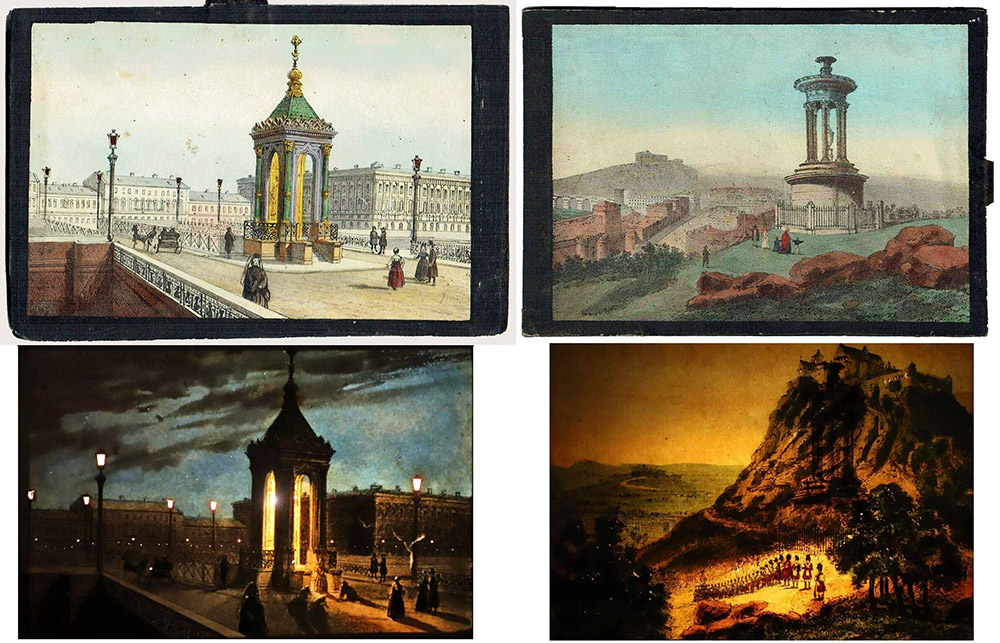
Figure 4.
Two Polyorama views (see the legend of Figure 3 for a description of how the device works). The left view changes from a daytime to a nighttime scene of the chapel on the Nicholas Bridge, St. Petersburg, Russia. The right view changes between two very different pictures of Edinburgh Castle, Scotland. Images adapted for nonprofit, educational purposes from an internet auction site.
Two records indirectly tell us that Louis Chevalier was born in about 1776-1778. He was reported to be 35 years old when he witnessed a marriage in 1813. An 1839 legal testimony transcript gave his age as 63.
Louis married Jeanne Louise Poisson on April 23, 1810. Their marriage contract described him as "ex-fusilier et ouvrier optician" ("ex-fusilier and optical worker"), indicating that Louis had previously served in the army. His parents were listed as Louis Vincent Chevalier and Charlotte Victoire Penseron. Louis Vincent Chevalier (1743-1805) was the founder of the Chevalier optical business that was assumed by Louis'elder brother Vincent Chevalier.
A record of Louise Jeanne Poisson's death on June 22, 1858 listed her heirs as Louis Victor Chevalier, Jerome Edme Chevalier, Alexandre Eduard Chevalier, and Joseph Louis Chevalier. I founds records that Jerome Chevalier was born ca. 1815 and died during 1874, and Joseph Louis was born ca. 1820 and died in 1884. Louis Victor Chevalier is very likely the man who was born in 1812 and operated an optician business from 1832 until ca. 1850, and who may have taken over Louis Chevalier's business after the father's death in 1848.
Louis Chevalier was a witness of the civil marriage ceremony of Honoré Marie Radiguet and Marie Agathe Bertaud. The bride was a daughter of Jean and Marie Françoise Elisabeth Victon Bertaud, who operated a long-lived optical business on Rue Saint Jacques (most notably by Marie after Jean's death). Louis was described as an "optician" who lived the Bertaud's address. From this, we can conclude that Louis Chevalier was an employee of the Bertaud optical business in 1813.
On August 29, 1818, "Louis Joseph Chevalier, optician, and Jeanne Louise Poisson, his wife" signed a 9-year lease for "two shops and various locations dependent on a house located 65, quai de l'Horloge. Annual rent of 1,200 francs, payable quarterly". Louis Chevalier was not listed in the 1818 Paris directory, but was afterward, giving us the information that his optical shop opened during the autumn of 1818. The rental contract gave Chevalier's current address as 85 Rue de la Verrerie, which was the address of a clock maker named Louis-Jacques Vaillant, suggesting that Louis was Vaillant's employee at the time.
The 1823 Dictionnaire Technologique included an article on the camera lucida, which credited Louis Chevalier with invention of a novel form that had been presented to the Société d'Encouragement. That was in error, as it was actually Vincent Chevalier who invented and presented that device, in 1819 (Dictionnaire Chronologique, 1822, and Figure 2, below).
The "Microscopes" section of the 1828 Dictionnaire Technologique stated that "c'est ainsi que M. Vincent Chevalier les exécute; il en a fait cependant de 2 lignes et demie et même d'une ligne de foyer, et son frère, Louis Chevalier, en a aussi fabriqué de pareils". ("Mr. Vincent Chevalier produces only achromatic lenses with four lines of focus, however, he has made lenses of two and a half lines and even one line; and his brother, Louis Chevalier, also made similar ones."). This implies that Louis Chevalier was manufacturing achromatic objective lenses during the 1820s.
On May 12, 1839, the Société des Saisons led an armed insurrection in Paris. Louis Chevalier witnessed an aspect of the attack, and later testified: "Chevalier (Jean-Louis-Joseph), age 63, optician, residing in Paris, quai des Lunettes (sic), no 65. (Heard, July 9, 1839, before M Zangiacomi, Deputy Investigating Judge.) On May 12, at half past three in the evening, when the first shots were heard, I took the precaution of closing my shop and the door of my driveway, to cut off all issues for the insurgents who were heading towards the dock (author's note: Quai de l'Horloge abuts the Seine River); after which I went up to my house, to my first floor. I had my children removed from the window and closed it. I remained there, however, driven by curiosity. The Quai was clear, and I couldn't see anyone there, when I saw something thrown through the window. On examination, I realized that they were cartridges which had been got rid of by an individual who was under my windows, who I could not see. I opened the window further and put my head out to try to see him, but I could only make out part of a frock coat which was fluttering in the wind, the man being in the recess of the door of my alley. A few moments later, two citizens approached the individual and spoke to him, I believe. I then noticed, and when these people took him away, no doubt to give him treatment, that he was injured in his left arm. A bullet had passed through. He had shed a lot of blood. I saw the profile of this man; he seemed to me to be brown and bearing sideburns. I doubt that I can recognize him; I think his frock coat was dark brown. After he left, the cartridges that I had seen discarded were collected by city guards who were passing by. I did not see if this individual had a rifle. I do not recognize the person that you show me as being the one in the recess of my alley near Sieur Tessier."
Possibly sensing that his life was near an end, Louis Chevalier's business became L. Chevalier et Fils during 1848. Louis died on November 10, 1848. Louis Chevalier et Fils may have been operated by son Louis Victor Chevalier, who previously had a shop nearby, but which disappeared from records after 1850.
The 1848 Annuaire Général du Commerce (printed in late 1847 – early 1848) lists Chevalier et Fils's address as 65 Quai de l'Horloge, while the 1849 edition (printed in late 1848 – early 1849) reported 25 Quai de l'Horloge. This may have been a renumbering of the street, as there were substantial renovations to the buildings along Quai de l'Horloge during the 1840s. The microscope shown in Figure 1 is inscribed "L. Chevalier et Fils" and the number 65 address, indicating production during 1848.
In 1849, "MM. L. Chevalier et fils, quai de l'Horloge-du-Palais, 65, présentent un nouveau genre de microscope adopté par le bureau de garantie de Paris pour la vérification des marques sur toute espèce de bijoux, quelles que soient leurs forms" ("Messrs. L. Chevalier et Fils, Quai de l'Horloge-du-Palais, 65, present a new type of microscope that has been adopted by the Paris guarantee office for checking marks on all kinds of jewellery, whatever their shape."). This microscope included a magnifying lens that can be adjusted in any direction, and object-holders that can also be freely adjusted, permitting views of the object at any angle (Figure 2). At that time, the manufacturer also announced production of a similar microscope, with parallel lenses and object holders, which allow the user to examine two objects simultaneously, and thereby compare a known hallmark with a questionable one.
At the 1849 Exposition des Produits de l'Agriculture et de l'Industrie, Chevalier et Fils was awarded an Honorable Mention for "leurs luneites antistrabismiques et leurs polyoramas" ("their antistrabismic glasses and their polyoramas"). "Antistrabismic glasses" would help to correct eyes that do not align correctly. Examples of polyoramas and views are shown in Figures 3 and 4, above.
The 1854 Annuaire Général du Commerce gave the address of L. Chevalier et Fils at 25 Quai de l'Horloge. The 1855 Annuaire showed a move, to 102 Rue de St. Antoine. Editions of the Annuaire from 1857 onward did not list L. Chevalier et Fils, but did include an L. Chevalier at 6 Grand Hurleur – it is not clear whether this was a continuation of L. Chevalier et Fils, or a different business. It is not known when the business founded by Louis Chevalier ended.
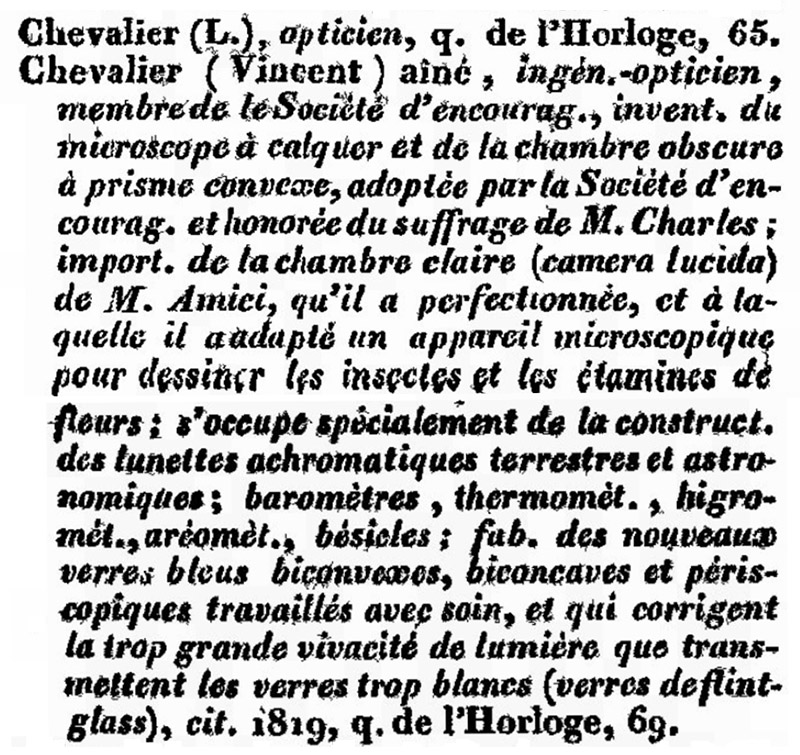
Figure 5.
Entries from the 1823 "Almanach du commerce de Paris", which clarifies that it was Vincent Chevalier, not brother Louis, who developed the camera lucida. Vincent had been in business since 1805 (having taken over his father's shop upon his death) and was evidently successful enough to pay for an extensive description of his business, whereas Louis had only been in business for about 4 years, and settled for a simple listing.

Figure 6.
Entry for Louis Chevalier from the 1842 "Almanach du commerce de Paris".
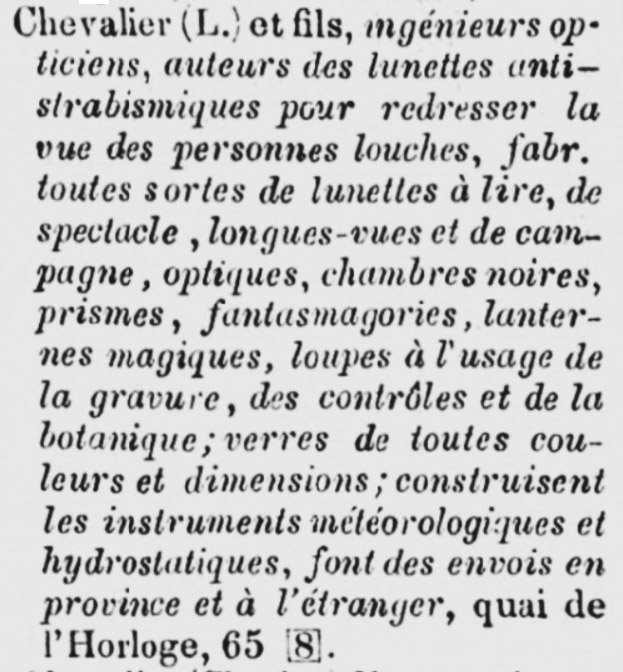
Figure 7.
Entry for Louis Chevalier et Fils from the 1848 "Almanach du commerce de Paris". The 1849 edition gave their address as 25 Quai de l'Horloge.
Acknowledgements
Many thanks to Albert Balasse for sharing images of his microscope and for continued support of the microscopist.net project.
Resources
Almanach du Commerce de Paris (1809) “Chevalier fils, quai de l’Horloge, 67”, page 240
Almanach du Commerce de Paris (1811) “Chevalier, quai de l’Horloge, 67”, page 284
Almanach du Commerce de Paris (1817) “Chevalier”, page 284
Almanach du Commerce de Paris (1818) “Vaillant – horloger mechanician, r. de la Verrerie 85”, page 201
Almanach du Commerce de Paris (1820) “Chevalier (Louis), optician fab., q de l'Horloge, 65”, page 432
Almanach du Commerce de Paris (1823) “Chevalier (L.), optician, q de l'Horloge, 65”, page 390
Almanach du Commerce de Paris (1823) “Chevalier (L.)”, page 260
Annuaire Général du Commerce (1847) "Chevalier (L.)", page 54
Annuaire Général du Commerce (1848) "Chevalier (L.) et fils … quai de l'Horloge, 65", page 590
Annuaire Général du Commerce (1849) "Chevalier (L.) et fils … quai de l'Horloge, 25", page 568
Annuaire Général du Commerce (1854) "Chevalier (L.) et fils … quai de l'Horloge, 25", pages 851-852
Annuaire Général du Commerce (1855) "Chevalier (L.) et fils … St-Antoine, 102", page 252
Annuaire Général du Commerce (1857) "Chevalier (L.), Grand Hurleur, 6", page 760
Birth record of Louis Victor Chevalier (1812) accessed through ancestry.com
Bulletin de la Société d'Encouragement pour l'Industrie Nationale (1849) Vol. 48, pages 187, 301-302, and 466-467
Chevalier, Charles (1829) Notice sur l’Usage des Chambres Obscures et des Chambres Claires
Cour Des Paris, Attentant des 12 et 13 Mai 1839 (1840) Testimony of Jean Louis Joseph Chevalier, accessed through www.senat.fr
Death record of Jean Louis Joseph Chevalier (1848) accessed through ancestry.com
Death record of Louise Jeanne Poisson ve Chevalier (1858) accessed through ancestry.com
Death record of Jérôme Edme Chevalier (1875) accessed through ancestry.com
Dictionnaire Chronologique et Raisonné des Découvertes (1822) Chambre claire, ou lucida camera, pages 537-538
Dictionnaire Technologique, ou Nouveau Dictionnaire Universel des Arts et Métiers (1823) Chambre claire, Vol. 4, pages 387-388
Dictionnaire Technologique, ou Nouveau Dictionnaire Universel des Arts et Métiers (1828) Microscopes, Vol. 13, pages 395-396
Famille RADIGUEY/RADIGUET (branche d'Ile-de-France) (accessed January, 2022) http://s.radiguet.free.fr/pages/Radiguet/RADIGUETParis.htm
Lease of 65 Quai de l'Horloge by Louis Joseph Chevalier and Jeanne Louise Poisson (1818) accessed through www.siv.archives-nationales.culture.gouv.fr
Marriage records of Jean Louis Joseph Chevalier and Jeanne Louise Poisson (1810) accessed through ancestry.com
Rapport du Jury Central sur les Produits de l'Agriculture et de l'Industrie (1849) page 529
Rapport de Exposition Universelle (1857) "Bertaud (Veuve), Paris, rue Saint-Jacques, 55", page 692






